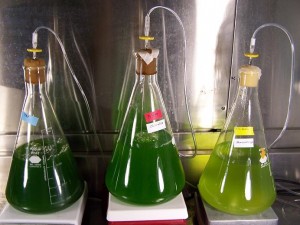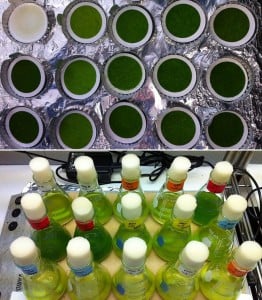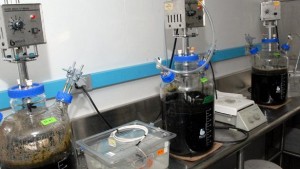Microalgae for biofuels and bioproducts
Note: The work described on this page represents a combination of completed projects and ongoing research. Please refer to our Publications page for a list of published articles.

Energy sources that provide an alternative to fossil fuels have seen renewed interest from scientists and the public in recent years. Concerns about national security, fuel prices and global geopolitics have motivated research into technologies that could reduce dependence on foreign oil. Renewable energy resources are particularly attractive in light of growing concerns about climate change, ecosystem health, extractive industries, and carbon neutrality. Biofuels, which are derived from recent biological materials, are a major category of renewables, and algal biomass is a promising source of biofuel. The principle is simple. Like photosynthetic plants, algae capture the sun’s energy and use it to convert CO2 from the air into biomass as they grow. The question is how to harvest the algae and recapture the energy in a way that is both economically feasible and environmentally sustainable.
Cultivation of Algae in Wastewater and Anaerobic Digester Effluent

Single-celled microalgae can clean polluted water, reducing the environmental impacts of waste and nutrient release to the environment. As they grow, the algae recapture resources from the waste, including carbon, nitrogen, and phosphorus. Because of this recapture, the products of algal remediation are potentially valuable: they represent a rich source of energy, animal food, and even biochemicals for use in medical applications and nutritional supplements.
However, existing microalgal technologies are not efficient enough to be commercially viable or even sustainable, so Bouwer group researchers are working to optimize the conversion of waste into algal biomass. We seek to fine-tune the process so that it will simultaneously generate a high-value product (suitable for use in biofuel or bioproduct feedstocks) and clean up the waste. Selecting the appropriate algal strains can help optimize growth, and devising a way to use nutrients recycled from wastewater could eliminate or significantly decrease the need for chemical fertilizers.
Mixotrophic and Heterotrophic Cultivation of Algae Using Extracts From Low-Cost Biomass
There are a number of inherent biological obstacles to using photosynthetic algae to turn waste and CO2 into biofuels while simultaneously cleaning up the environment. The first is productivity. Microalgae grown photosynthetically will reach only limited densities, and the cells can grow only in the top few centimeters of water because there isn’t enough sunlight at greater depths. The second difficulty relates to the composition of the algae: they accumulate only limited amounts of fats in their cells (15-25% lipid yield), but these lipids are the most valuable component when it comes to converting algae into biodiesel or other liquid fuels.

One approach to address these problems is to supply some organic carbon. Supplementing photosynthesis by feeding the algae simple sugars promotes growth in a mode that is called “mixotrophic.” In fact, many microalgae can also grow entirely without sunlight in “heterotrophic” mode, using just the supplemental sugars. Both mixotrophic and heterotrophic growth can increase productivity and improve cell composition. In our lab, we have achieved lipid yields approaching 50% mixotrophically or heterotrophically.
Unfortunately, growing microalgae on supplemental sugar instead of sunlight and CO2 not only negates many of the sustainability benefits of photosynthetic growth, it also carries major economic disadvantages. Feeding algae sugars like glucose at the levels necessary for high lipid yields is still too expensive, and further additions of nitrogen and phosphorus are required. But if it were possible to meet the algae’s mixotrophic carbon and nutrient requirements using inexpensive or waste-derived sources, microalgal biofuels would become more economically viable and some of the sustainability benefits would be regained. A second line of research in the Bouwer group correspondingly focuses on converting low-value biomass (e.g., duckweed) into a nutrient-rich feed source for mixotrophic and heterotrophic cultivation of microalgae with high lipid yields.
Anaerobic Digestion of Whole Algae and Post-Extraction Algal Residues
After lipids have been harvested from algae, there is a significant amount of post-extraction algal residue left over. Capturing the energy and recycling the nutrients present in this byproduct may be essential to the economics and the sustainability of the process as a whole. Furthermore, techniques to capture energy from the low-lipid byproduct could also be applied to capture energy from microalgae with naturally low lipid content, thus expanding the list of useful algal strains to include several robust and productive species that grow well in wastewater.

One technique for energy and nutrient recapture is anaerobic digestion (AD). AD converts all classes of organic matter to biogas, which is a mixture of mostly methane and carbon dioxide. The process is compatible with both low-lipid biomass and nutrient recycling. Our calculations for low-lipid algae show that the potential energy yield for conversion to biogas via AD is significantly higher than the energy yield from converting the lipid fraction to biodiesel. But the highest potential energy yield comes from coupling both processes: first extracting lipids for conversion to biodiesel and then converting the post-extracted residues to biogas.
Unfortunately, the rigid cell walls present in many unicellular algae are highly resistant to degradation. For some species, they can remain intact even after several months of anaerobic digestion. In general, the amount of algal organic matter that is converted to final products during AD ranges from 20 to 60%. These levels are unacceptably low, and effective methods to break down the remaining algal biomass are an essential prerequisite for making biogas production from algae commercially viable. The Bouwer group is correspondingly pursuing a third line of research into thermal, thermochemical, microwave and enzymatic pretreatment methods that can hydrolyze the recalcitrant fractions of algal biomass. We are also trying to optimize operational parameters for AD, determine the fraction of nutrients that can be recovered and recycled back to the cultivation stage, and improve the carbon/nitrogen balance through co-digestion with lignocellulosic biomass.
